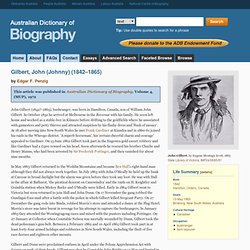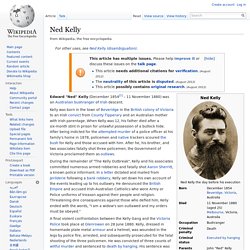

Bushranger. History[edit] More than 2000 bushrangers are believed to have roamed the Australian countryside, beginning with the convict bolters and drawing to a close after Ned Kelly's last stand at Glenrowan.[3] 1850s: gold rush era[edit] The bushrangers' heyday was the Gold Rush years of the 1850s and 1860s as the discovery of gold gave bushrangers access to great wealth that was portable and easily converted to cash.

Their task was assisted by the isolated location of the goldfields and a police force decimated by troopers abandoning their duties to join the gold rush.[3] George Melville was hanged in front of a large crowd for robbing the McIvor gold escort near Castlemaine in 1853.[3] 1860s to 1870s[edit] Bushranging numbers flourished in New South Wales with the rise of the colonial-born sons of poor, often ex-convict squatters who were drawn to a more glamorous life than mining or farming.[3] Much of the activity in this era was in the Lachlan Valley, around Forbes, Yass and Cowra.[3]
Ned Kelly. On Tuesday morning, to the disgust of some of the onlookers, the body was taken outside and slung up against a door to be photographed.

The features were composed in a natural way and easily recognised. The face had full, fine forehead, blue eyes, downy moustache and a bushy beard covering a full chin, whilst the curly hair had recently been cut. The figure was of a well built, lithe young fellow and the face beautiful, nevertheless the spectacle was repulsive. The hands were clenched in the agony of death and covered with blood. Blood stained the blue sack coat and strapped tweed trousers, which, even in death, Joe wore with loose grace. Joe's high-heeled boots were his trademark, being referred to as larrikin heels during late nineteenth century Victoria. My name is Ned Kelly, I’m known adversely well. Accounts say that, a moment before the bullet struck Joe Byrne dead, he offered the toast “Here's to the bold Kelly Gang!”.
John Gilbert. John Gilbert (1842?

-1865), bushranger, was born in Hamilton, Canada, son of William John Gilbert. In October 1852 he arrived at Melbourne in the Revenue with his family. He soon left home and worked as a stable-boy in Kilmore before drifting to the goldfields where he associated with gamesters and petty thieves and attracted suspicion by his flashy dress and 'flush of money'. At 18 after moving into New South Wales he met Frank Gardiner at Kiandra and in 1860-61 joined his raids in the Wheogo district. 'A superb horseman', his 'certain cheerful charm and courage' appealed to Gardiner.
In May 1863 Gilbert returned to the Weddin Mountains and became Ben Hall's right-hand man although they did not always work together. Gilbert and Dunn were proclaimed outlaws in April under the Felons Apprehension Act with £1000 on each of their heads. Citation details Edgar F. Ned Kelly. Edward "Ned" Kelly (December 1854[1] – 11 November 1880) was an Australian bushranger of Irish descent.

Kelly was born in the town of Beveridge in the British colony of Victoria to an Irish convict from County Tipperary and an Australian mother with Irish parentage. When Kelly was 12, his father died after a six-month stint in prison for unlawful possession of a bullock hide. After being indicted for the attempted murder of a police officer at his family's home in 1878, policemen and native trackers scoured the bush for Kelly and those accused with him. After he, his brother, and two associates fatally shot three policemen, the Government of Victoria proclaimed them as outlaws. During the remainder of "The Kelly Outbreak", Kelly and his associates committed numerous armed robberies and fatally shot Aaron Sherritt, a known police informant.
A final violent confrontation between the Kelly Gang and the Victoria Police took place at Glenrowan on 28 June 1880. Family background and early life.